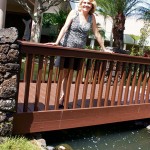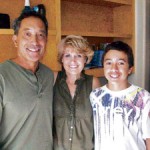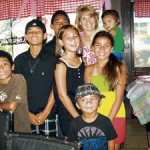When there’s a Death in the Family
She was named one of YWCA’s Na Wahine of the Year for picking up people in their darkest hour. The former Kaua’i Hospice bereavement coordinator, who is now a victim advocate and executive director for Life’s Bridges, Gina Kaulukukui knows all too well how hard it is to deal with the sudden death of a loved one.
Perhaps that’s why she is so good at what she does. She’s lived it.
“I think my calling came early on,” she says. “I was 4 when my father committed suicide. I can remember every detail of the phone call when my father was discovered.”
It’s an experience that changed her life and also awakened her to the unfair stigma with which survivors of tragedy often have to deal.
“I can tell you 53 years ago we were not allowed to talk about it in our family,” she says. “My mother was a young widow with two small children. I knew that something was terribly wrong – here he was one day, and gone the next. But I never knew how he died until I was 18.”
Kaulukukui says it was an English teacher in her senior year at Kapa’a High School who reached out in her time of need: Josephine Sokei gave her the book Death is a Noun.
“It was the first time I read anything that referenced death as a natural part of life,” she says. “It is what inspired to me to learn more about grief and to be open about it.”
Kaulukukui established Life’s Bridges five years ago. It’s a Kaua’i United Way agency dedicated to suicide prevention and bridging the gap between tragedy and what she calls a “grief journey.” Often dispatched by KPD in response to emergencies at any time of day or night, Kaulukukui also collaborates with EMTs, Kaua’i Veterans Memorial Hospital and Mahelona, among others.
As part of the island’s suicide prevention task force, Kaulukukui also helps local families and visitors deal with the death of a loved one after the fact. It’s a skill that friend and colleague Sue Kanoho, executive director of Kaua’i Visitors Bureau, appreciates. (Kanoho nominated Kaulukukui for Woman of the Year.)
“Gina goes above and beyond in those difficult moments and provides comfort to those who are suffering the loss of a loved one,” she says. “That’s why I nominated Gina, because her commitment and service to those in need amazes me on a daily basis.”
Though she didn’t go into grief and prevention work as a career right away (she started out as a buyer for Liberty House), Kaulukukui made a career change following the birth of her first child Brandon, now 33.
“He was given less than a 50 percent survival rate,” she says. “I said to God, ‘If you let me be this child’s mother, I will find a way to give back.'”
Kaulukukui remembers it was Dr. Patrick Aiu who saved her son’s life using steroids to develop Brandon’s lungs. Following the birth of her “perfect” 3-pound baby who had no developmental problems, Kaulukukui started doing things on a state level with March of Dimes and became its spokeswoman in 1983.
“I started to speak out about my son,” she says. Kaulukukui became an advocate of early screening methods and early childhood education (up to age 3) to give parents and children the tools they need to grow and prosper.
By 1985, Kaulukukui was a patient advocate for Kaua’i Medical Clinic and started a support group for parents who had children born prematurely.
“We had a parent whose child died and nobody in the hospital knew what to do,” she says. “They said, ‘Gina, you do it.’ I didn’t have training.” But with the help of the book When Hello Means Goodbye, written by RNs Pat Schwiebert and Paul Kirk, Kaulukukui says she was able to offer a sensitive approach to the family during what would otherwise have been an inconsolable time of grief.
“It said to hold the baby, name the baby,” she says. “I remember asking the doctor for a lock of the baby’s hair. All I knew was, as a mom, I have lockets of hair, footprints and handprints – I have all these things that celebrate life. When a child dies, don’t we want to celebrate them even though we don’t have long-term memories?”
Kaulukukui says the response of the grieving father showed her instincts to be correct.
“He came down and thanked me for telling him to take pictures,” she says. “I hadn’t told him I had asked for the locket of hair, and I said, ‘This is what my instincts told me to do,’ and handed it to him. You would have thought I gave him a million dollars. He said, ‘You will never know how much this means to us.'”
Though she moved to Oahu in 1987 and spent eight years working for HUGS and Ronald McDonald House, she was able to move back to Kaua’i in 1995, and worked as Kaua’i Hospice volunteer and bereavement coordinator for 13 years until she began Life’s Bridges.
Now, having helped others for more than three decades, Kaulukukui says she believes it is a career path to which she was called.
“I am a true believer when you get into the arena of death and grief, that becomes your life’s work,” she says. “That isn’t something you choose.”
At Life’s Bridges, Kaulukukui continues to offer that final way to connect with someone who has died, whether it’s working with KPD to allow a family to visit the deceased, or creating a physical keep-sake of someone who has died.
“We try to make hand-prints with lockets of hair because we realize it’s like a hug from your child,” she says.
Dealing with the loss of a child is obviously a life-changing event, but it’s clear that Kaulukukui offers a kind and sensitive transition into that place. Because the island is small, it’s also something that often haas included helping friends or friends of family.
Such was the case when Payton Kekaialoha Bryan-Chung died in 2005 at the age of 9. Chung had dug a hole, climbed in and fell. Kaulukukui helped his mother, Maile Bryan, at that time.
“One of the things I did was put her handprint and his handprint together so they were always touching. She has become an incredibly great friend.” Bryan volunteers and helps and reaches out to other grieving families, in what Kaululukui calls “an amazing way to give back and honor Payton.”
When it comes to suicide, sometimes warning signs are blatant and other times subtle. Kaulukukui also is there for families, and says most suicides are preventable.
“Most,” she says. “I wish I could say everybody’s suicide is preventable.”
Kaulukukui’s brother, who also committed suicide, told her of his plans to do so.
“He died drunk in a car going 90 mph, passing five cars,” she says. “I remember I was with him in November, and during this ride he said that he was going to die. He was 32. He said he was going to kill himself. I said, ‘How can you have this conversation knowing the impact this had on our lives?’ He said, ‘If our dad could do it, I can do it.’ I said, ‘Let me get you help.’ He said, ‘I can’t do this anymore, I’m done.’ It was his out. He was in such emotional pain.”
To date this year, eight people have committed suicide on Kaua’i. In 2011 there were nine suicides, and in 2010 there were 16, preceded by nine in 2009. Many residents likely remember 2008, which was a particularly difficult year, as there were six suicides in the month of October alone, including three teenage deaths in Anahola.
“I think it made everyone realize we can’t put blinders on,” she says. “We had to start talking about suicide and the impact it has on our island.”
Though some might have surmised it was the 2008 economy that created that peak month of suicides, Kaulukukui believes it was more about extreme emotional pain than anything else.
“But there isn’t one thing,” she says. “There is just the final straw – it’s cumulative.”
When a suicide happens, it is important for the community to be able to talk about it, to grieve and heal, and to break the stigma attached to it.
“It is not helpful to have to live in quiet or in shame,” Kaulukukui says.
“Our goal when somebody dies is to shift from how they died to how they lived. And it isn’t a concept people think about naturally. Most of what the survivor feels is guilt. I call it the ‘woulda-shoulda-coulda.'”
It’s a part of the grieving process that Kaulukukui continues today.
“We have such an amazing community of people who really do care,” she says. “When there is a crisis, people show up. When people die, people show up. That is what separates us from the rest of the world. That is something about being called to a scene in one of the most intimate moments in our life. When we are called in it, it is in a sense birthing someone out of the world. And they’re entrusting us with their healing.”
When she’s not helping others through a crisis, Kaulukukui loves to travel and recently took a month-long trip to Europe. Besides travel, she enjoys time with husband Roddy, a pool attendant at the St. Regis, and 10 grandchildren.
“My kids were rabbits in another life,” she says with a laugh. Eight of her grandchildren are on Kaua’i: Braxton (13), Caiden (12), Pua (11), Ashton (9), Kawika (9), Kona (5), Tavian (5), Akoni (2), Keyston (4 months), Keani (2 months). “I am very blessed to be surrounded with life.”
- Gina Kaulukukui of Life’s Bridges is there when a loved one commits suicide or dies suddenly. As the daughter and sister of suicide victims, her counsel in a person’s ‘grief journey’ comes from her own personal experience
- Gina Kaulukukui at Life’s Bridges office in Lihu‘e. Amanda C. Gregg photo
- With husband Roddy and son Nainoa
- with grandchildren Photos courtesy Gina Kaulukukui
- Kaulukukui. Amanda C. Gregg photo
- Receiving her Na Wahine Alaka‘i O Kaua‘i award, from left: state Sen. Ron Kouchi, honorees Carla Thomas, Gina Kaulukukui and Ellen Ching, state Rep. Dee Morikawa and Derek Kawakami present them with their awards. Photo courtesy Sue Kanoho









